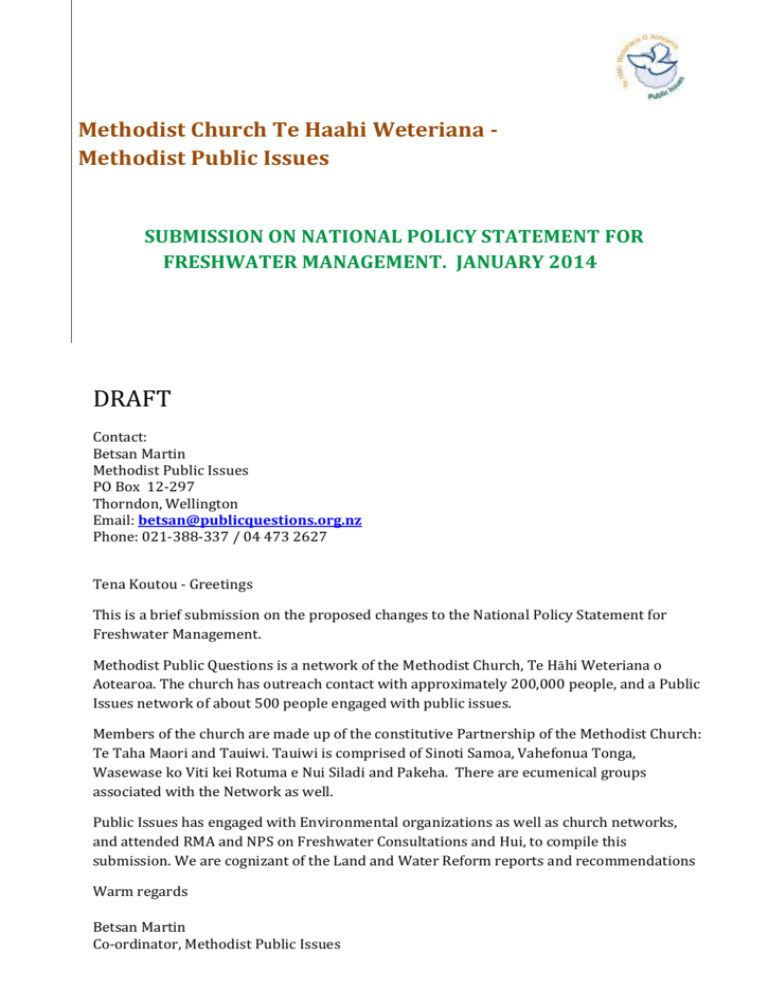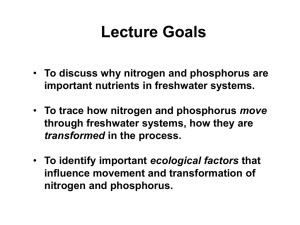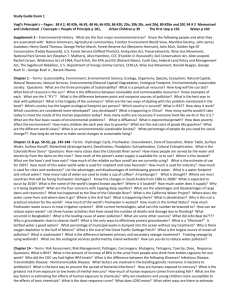Submission on National policy statement for freshwater
advertisement

Methodist Church Te Haahi Weteriana Methodist Public Issues SUBMISSION ON NATIONAL POLICY STATEMENT FOR FRESHWATER MANAGEMENT. JANUARY 2014 DRAFT Contact: Betsan Martin Methodist Public Issues PO Box 12-297 Thorndon, Wellington Email: betsan@publicquestions.org.nz Phone: 021-388-337 / 04 473 2627 Tena Koutou - Greetings This is a brief submission on the proposed changes to the National Policy Statement for Freshwater Management. Methodist Public Questions is a network of the Methodist Church, Te Hāhi Weteriana o Aotearoa. The church has outreach contact with approximately 200,000 people, and a Public Issues network of about 500 people engaged with public issues. Members of the church are made up of the constitutive Partnership of the Methodist Church: Te Taha Maori and Tauiwi. Tauiwi is comprised of Sinoti Samoa, Vahefonua Tonga, Wasewase ko Viti kei Rotuma e Nui Siladi and Pakeha. There are ecumenical groups associated with the Network as well. Public Issues has engaged with Environmental organizations as well as church networks, and attended RMA and NPS on Freshwater Consultations and Hui, to compile this submission. We are cognizant of the Land and Water Reform reports and recommendations Warm regards Betsan Martin Co-ordinator, Methodist Public Issues National Policy Statement on Freshwater This submission refers to the Ministry for Environment discussion document on proposed changes to National Policy Statement for Freshwater Management includes information from Environment organizations and the Land and Water Forum. The 2011 National Policy Statement for Freshwater Management requires regional councils to: maintain or improve overall water quality within a region safeguard the life-supporting capacity, ecosystem processes and indigenous species (including their associated ecosystems) of fresh water set freshwater objectives and limits for all water bodies. Public Issues has concerns about the standards for water quality being too low and would like to highlight several points for consideration and inclusion in the amended National Policy Standards – Freshwater Management. 1. Compulsory Values The two proposed compulsory values of ecosystem health and human health need to include an account of land use and assessment of the impacts from dairying and urban contamination. These should be included in criteria for ecosystem health. We introduce further values for consideration. We propose consideration of vesting water as a Public Trust governed as a Te Tiriti o Waitangi partnership. Public trusteeship, as exemplified in Hawaiian constitutional law, moves the focus on use rights to an onus on responsibility for present generations to act as trustees of the Earth’s ecological systems to ensure their own continuity for future generations. Similarly the concept of ecological integrity, which we commend as a further value, is an objective with requirements to restore and maintain the chemical, physical and biological integrity of the nation’s waters (as in 1972 US Clean Water Act). These approaches move us towards an understanding of humanity as part of the biosphere and our need to seek a relationship with water and the biosphere of mutual benefit, and that is oriented to human responsibility for ecological integrity. Submission proposal Consideration be given to including ecological integrity as a compulsory value That freshwater be accorded the status of a Public Trust 2. National Objectives framework for NPS-FM We support the endeavour to strengthen the standards for the improvement of the National Policy Statement on Freshwater Management. In particular we support the intention to maintain or improve overall water quality within a region, safeguard the life-supporting capacity, ecosystem processes and indigenous species (including their associated ecosystems) of fresh water. Setting Freshwater objectives and limits for all water bodies and water ecosystems in Aotearoa New Zealand is strongly supported, as is the provision for collaboration at Council levels for selecting values for Freshwater and implementing the National Policy Standards. 1 Ecosystems and Land Use Land use is the key issue for river management and water quality. The objective for integration of water management and land use is fully supported, as stated in Objective C1: To improve integrated management of fresh water and the use and development of land in whole catchments, including the interactions between fresh water, land, associated ecosystems and the coastal environment (MFE Proposed amendments to NPS, P. 57). The key message of the Parliamentary Commissioner for the Environment Report is that dairying is expanding and intensifying, and in spite of measures to manage nitrogen from effluent, the amount of nitrogen in freshwater will continue to rise with corresponding degradation of water (Parliamentary Commissioner for the Environment. Water Quality in New Zealand Nov. 2013 < www.water-quality-in-new-zealand-land-use-and-nutrient-pollution>). Urban water quality issues include stormwater management and improved urban design to achieve integration of water standards in urban settings. Emphasis needs given to be given to constructed wetlands, which can be used or created for cleaning stormwater. Greenfield designs like swales, are a technique for rainwater harvesting. Brownfields are abandoned or underused industrial sites which might also be contaminated. Subsidies to encourage clean up with decontamination and redevelopment are strategies for improving land use in urban areas and include green initiatives such as rainwater harvesting systems on houses or rain-gardens. Ecosystem health includes taking account of land use and assessing the impacts from dairying and urban contamination. These should be included in criteria for ecosystem health Several aspects of ecosystem health and integrated management need development in the amendments to strengthen an account of land use impacts on water. a. National freshwater management needs to provide an account of the effects of land use on water quality. b. The expansion and intensification of dairying is the main cause of nitrogen pollution in rivers, and degradation is set to rise. c. Urban issues include stormwater management with solutions such as rain water collection and cleaning up contaminated industrial sites. d. Wetlands, estuaries and groundwater are identified in the narrative proposals (p, 20, 21, 47), and estuaries (p. 47). The Attribute Tables do not include wetlands, estuaries, or groundwater. The discussion document excludes measures for ground water: ‘The science around ecosystem health for groundwater is in its early stages. As a result, no attributes have been defined for groundwater’ (p. 20). We urge inclusion of ground water levels as nitrate levels are increasing and the time-lag effect on water must be accounted for and assessed. The Attribute Tables therefore are not complete. Further Attributes that are missing include Fish, Macroinvertebrates (insects), Sediment and Dissolved Oxygen. Biological communities need to be included. Macroinvertebrates are important in river ecosystems and are a strong indicators of water and ecosystem health. Good numbers of stonefly and mayfly nymphs indicate the likelihood of good water quality. The condition of fish, including native fish such as Tuna, is an important indicator of ecosystem health. Indices of biological diversity are able to be measured with protocols for fish and invertebrates. 2 Assessments of the impact of dams, barriers and stop banks are available from some regions and can be interpreted for the Assessments. On the negative side, pine forestry is likely to be associated with erosion and sedimentation. Although sedimentation may have natural variations there needs to be guidance to give consistency to Councils to set objectives for sediment management with timeframes to achieve ecosystem health. Dissolved oxygen is a strong indicator of pollution in rivers. Under the National Policy Statement it is proposed to measure dissolved oxygen below wastewater plants. Oxygen pollution from dairy farms (as well as nitrogen) is the more likely than wastewater to impact on water quality. The measures need to be done in dairy farming catchments. The Macroinvertebrate Community Index, Sediment and Dissolved Oxygen all need to be included in the measures in the Attribute Tables. The Attribute Tables are largely focussed on selected water bodies, ie Lakes and Rivers; and on human bodies. The attributes do not include wetlands or estuaries. Further assessments should include: Water clarity and quality: These are linked to human health attributes of swimability and drinkability. Pathogens and Periphyton/cyano bacteria: These are significant for human health. Measures for E.Coli, Cyanobacteria and benthic levels should be measured at a level of safety for swimming using Ministry of Health guidelines. Many Treaty settlements have strong provisions for freshwater management with legislation that takes precedence over National policy. Some Iwi, such as Tainui, have set high standards for water quality, defined as bringing water to a drinkable quality – a much higher standard than that proposed in the National Policy on Freshwater. Public Issues submits that councils take account of Iwi Management Plans and that the higher standards should provide the benchmark for regional objectives with timeframes. Water temperature. Water temperature is a poorly recognized aspect of river dynamics. Temperature contributes to the regulation of sediment and shade is therefore a further indicator of river health. Submission proposals A more complete set of criteria for National Standards for catchments is needed to provide guidance to Councils is needed to achieve both consistency and responsiveness at local levels. Attributes and assessments need to include indicators of ecosystem health that include land use, both rural and urban, with explicit account of the effects of land use on water quality. Ecosystem health of catchments must include wetlands, estuaries and groundwater. Attribute tables with corresponding numerical values and narrative explanations need to be added. 3 Water quality measures need to include clarity, pathogens and periphyton/cyano bacteria. Measures for E.Coli, Cyanobacteria and benthic levels should be measured at a level of safety for swimming using Ministry of Health guidelines. Attributes and Assessments for ecosystem health include Fish and barriers to fish migration, Macroinvertebrate Community Index, Sediment and Dissolved Oxygen, and Water Temperature. Human health indicators (pathogens, periphyton, cyano bacteria, water clarity) to a swimmable level using Ministry of Health, Biggs standards and other appropriate guidelines Objectives have to be made consistent with the RMA Attribute tables include identified indicators of Te Mana o Te Wai (see S. 4 below). 3. National Bottom Lines and Minimum Standards The requirement of no further degradation is an important criteria, particularly as a standard of responsibility for future development. The level of nitrogen proposed for the Bands in the Attribute Tables is of significant concern. We understand that there is a serious discrepancy between the current guidelines and the proposed levels of nitrogen. There is discrepancy between the current guideline for Band A, which is .44mg/Litre, whereas the proposed level of nitrogen allowed is 1mg/Litre. This is double the allowance of the current guidelines. The minimum standards are set at the bottom of Band C (fair) in the Attributes table. This is a ‘secondary contact’ level of water quality (for boating and wading). With 90% of New Zealand Freshwater being below swimmable standards we consider a higher standard is appropriate and propose a minimum standard being set in the (amended) B Band (good). We advocate for ‘contact’ recreation as a minimum standard ( ie swimmable). This will mean a requirement to identify where this standard is achievable with a time-frame. Ideally there should be a goal of ‘drinkable’ standards. The requirement for ‘overall’ standards within Council jurisdiction may allow for further degradation within a region, by allowing high standards in one river to be offset by low standards in another. We therefore propose that standards be set for each river in a catchment. Submission Proposals The levels of nitrogen in the Bands be amended to levels that set levels to at least the current guidelines, which correspond to .44mg/L in Band A. Objective A2 in the Preamble require that each Freshwater Management Unit within a region be required to be maintained or improved That the Minimum Standards should be set in the B Band – rather the current low standard at the bottom of the C Band. 4 Exemptions Exemptions to Compulsory values and national bottom lines are provided for where there are transitional conditions, and where it is ‘not reasonably practical’ to raise standards. Submission Proposal A more rigorous provision which reads ‘Where freshwater management Units are below the bottom line an exemption is allowed where it is not possible to raise standards’. 4. Tangata Whenua Values, Iwi/Māori as Treaty partners As proposed in 4.6 (MfE, NPS-FM p. 29) the NPS-FM Preamble does not currently include a statement of tangata whenua values such as mahinga kai, food security and irrigation. Public Issues supports the addition of the explanation of Te Mana o Te Wai in the preamble (MFE NPSFM p.48), and proposes that the values of Mana o Te Wai , such as natural form and character included in compulsory values. We consider that reference to Te Tiriti o Waitangi should be included in the Preamble, with an elaboration included of the te Tiriti agreement to ensure protection of rangatiratanga and of water as a taonga. Many Treaty settlements have strong provisions for freshwater management with a legislated requirement for the relevant Councils to have regard for the standards in the Iwi Management Plan. Some Iwi, such as Tainui, have set very high standards for water quality, defined as bringing water to a drinkable quality – a much higher standard than that proposed in the National Policy on Freshwater. The National Policy Statement needs to include recognition of water standards set by Iwi Management Plans and ensure provision for reconciling Iwi standards with National Standards. Submission Proposal The Preamble include a statement of Te Tiriti o Waitangi co-governance model for Freshwater and include an explanation of Te Tiriti guarantees of tino rangatiratanga and of water as a taonga. The overall Objectives proposed in A2 include safeguarding Te Mana o Te Wai The requirement for Councils to have regard for Iwi standards for freshwater in Iwi Management Plans be recognized in the NPS-FM. Where Iwi standards are higher than the National Minimum Standards or Regional standards for water, we propose the NPSFW include a requirement to set a timeframe for Councils and Iwi to work together to achieve Iwi standards. Conclusion In conclusion Public Issues affirms support for matters of long term care, stewardship and responsibility for Freshwater, including full regard for Iwi/Māori interests. The church speaks for ethical commitments to environmental integrity, and is pleased to contribute to decision-making on National Standards for Freshwater. With respect 5 Betsan Martin for Public Issues, Methodist Church, Te Hāhi Weteriana o Aotearoa 6









